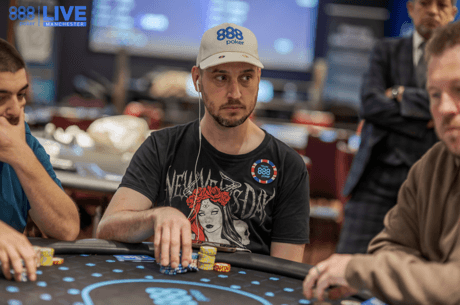Debating Decisions: Learning from Others While Watching the 2014 WSOP Main Event

When watching the World Series of Poker Main Event on television, it’s easy to get lost in the spectacle of it all. It’s the biggest stage in poker and the pressure on players is immense. Such circumstances make for entertaining viewing for sure, but if you’re serious about poker you should also use what you are watching as a learning tool. There are plenty of mistakes being made, and smart plays, too. While watching you should be putting yourself in the players’ shoes and considering what you would do when faced with similar decisions.
This article is going to look at a few hands from the most recent 2014 WSOP Main Event episodes aired on ESPN and consider in each what players could have done differently. Of course, we have both hole cards and hindsight to aid in our second-guessing; however, these hands still provide many opportunities for reviewing various strategic considerations as we learn from others’ play.
Hand #1: Dan Smith vs. Andrey Zaichenko
The blinds were 40,000/80,000 with a 10,000 ante. Dan Smith started the hand with 3.25 million and Andrey Zaichenko had 6.76 million. It was folded to Smith in the small blind who completed with 9♠5♥. Zaichenko checked his option with 10♣9♣.
The flop came Q♠J♣10♠ and Smith led out for 125,000. Zaichenko called. The turn was the Q♣ and Smith bet again, this time for 325,000, and Zaichenko called once more. The river was the 6♠ and Smith fired a third bullet, for 675,000. Zaichenko folded.
What Zaichenko could have done:
Zaichenko failed to utilize his positional advantage in this hand, something that could have helped the successful pro avoid losing this pot. A raise on the flop and/or turn would most likely have taken down the pot right there or at minimum shut down Smith from firing another bet, thereby giving Zaichenko’s hand the potential for reaching showdown and winning.
Hand #2: Iaron Lightbourne vs. Dan Smith
Again, the blinds were 40,000/80,000 with a 10,000 ante, and Iaron Lightbourne opened to 175,000 from early position with 3♦3♣. It was folded to Smith in the big blind who reraised to 525,000 with A♥K♥. Lightbourne then four-bet to 1,075,000, and when Smith moved all in Lightbourne snap-folded.
What Lightbourne could have done:
The British pro here turned his hand into a bluff instead of a hand that had any value. He might have considered that since his initial raise was from early position, Smith — having narrowed Lightbourne’s range accordingly — was probably not reraising lightly from the blinds. Calling and reacting to Smith on the flop was more likely a better line to take than putting in a four-bet that was too small to induce a fold in the first place.
Hand #3: Bryan Devonshire vs. Matt Haugen
The blinds had increased to 50,000/100,000 with a 10,000 ante, and Bryan Devonshire opened in early position to 220,000 with K♠K♦. Leif Force called with A♣Q♣ from middle position and Matt Haugen called the additional 120,000 from the big blind with 9♣4♣.
The flop was a miracle for Haugen, coming 10♥4♦4♠. He checked, Devonshire bet 325,000 into the pot of about 800,000, Force folded, and Haugen called. The turn was the 3♦ and both players checked. The river was the J♠ and Haugen sprang into action, betting 900,000 into the 1,450,000-chip pot. Devonshire made the call.
What Devonshire could have done:
Not a thing. I’ve included this hand because it’s a good learning example of how you should play a hand like pocket kings in such a spot. Devonshire doesn’t go nuts (or broke) here because he recognizes the situation.
A first warning sign for Devonshire was Haugen check-calling the flop. Recognizing this, Devonshire checked behind on the turn to keep the pot small and allow him to not get blown off of his premium hand. On the river, Haugen makes a large bet of nearly two-thirds the pot. There’s not much reason for Devonshire to fold here, but plenty of reason for him not to raise. He correctly calls and lives on to play longer because of the mindful approach he took in the hand.
Hand #4: Peter Placey vs. Martin Jacobson
It was the same level, and Peter Placey raised from the hijack with A♥Q♥ for somewhere between 200,000 and 300,000 (ESPN doesn’t show the amount). Martin Jacobson was on the button with A♣K♥, and he reraised to 500,000. It folded back to Placey who four-bet to 1,200,000 and Jacobson called, making the pot 2.64 million.
The flop was A♠5♠4♣ and Placey moved all in for 4,705,000. Jacobson made the call and would eliminate Placey after the 2♥ turn and 6♣ river.
What Placey could have done:
I actually don’t mind Placey’s preflop four-bet as Jacobson is a tough pro who could easily be three-betting lightly from the button. Once Jacobson calls, however, Placey should have recognized that Jacobson likely had a strong hand. Placey’s bet-sizing on the flop is obviously not recommended — as Norman Chad correctly pointed out, the only hand that would call that bet would be one that beats Placey’s. With nearly 50 big blinds behind, a bet of 1-1.25 million would have been better, and if Jacobson called or raised, Placey could then evaluate how he wanted to proceed. By moving all in, he doesn’t allow himself that opportunity.
Get all the latest PokerNews updates on your social media outlets. Follow us on Twitter and find us on both Facebook and Google+!









